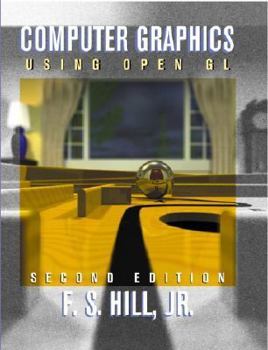Computer Graphics Using OpenGL
Select Format
Select Condition 
Book Overview
No Synopsis Available.
Format:Hardcover
Language:English
ISBN:0023548568
ISBN13:9780023548567
Release Date:May 2000
Publisher:Prentice Hall
Length:922 Pages
Weight:4.25 lbs.
Dimensions:1.6" x 8.3" x 10.3"
Customer Reviews
5 ratings
I'm excite about this book
Published by Thriftbooks.com User , 23 years ago
If your a student or teacher of computer graphics this a great book to use. I've been teaching opengl (WSU Virtual Worlds on the Web) for six years and find the vast variety of ideas and problems to solve very interesting. The author explanations are clear and easy to transfer to students. Student response to the book seems to be very positive. I also recommend purchasing the Opengl Superbible 2nd edition as a reference book (the code samples are great). My only suggestion is to provide a CD with a cross sections of opengl code samples to be used with the book. But, bottom line this book rules.
Makes learning Computer Graphics **fun** !!
Published by Thriftbooks.com User , 23 years ago
This is an excellent first book on Computer graphics using OpenGL - very accessible and enjoyable at the same time, with a good breadth of coverage as well. I took a course under Prof. Hill while he was a visiting Prof. at the Indian Institue of Science, which used the draft of this book. We had a great time learning graphics with Prof. Hill - his enthusiasm is infectious, and this comes out in the textbook as well. We were able to develop a 'Tour of the Tajmahal' by the end of the course, with lots of special effects (like texturing, flying objects) - it was **beautiful** :-) !! The book covers all the usual material expected in a Computer graphics textbook - transformations, modeling, texturing, hidden surface removal ........, as well as somewhat 'advanced' topics like ray-tracing.The writing style is engaging and the explanations are very clear - this is a book that makes it easy to learn graphics. It also contains helpful tutorial material for all the maths background required, and a really huge number of exercises - obviously, you need not do all of them, just take your pick. Please note that it is **not** a tutorial/reference on OpenGL - it merely uses OpenGL as the tool of choice for writing graphics code. If you want to learn OpenGL, please check out the 'Official guide to learning OpenGL' by Woo et al - we used that text in conjunction with this in our course, and it's really helpful for getting upto speed with OpenGL.All in all, this is an excellent choice if you want an uptodate text on Computer graphics using OpenGL.
A great academic text
Published by Thriftbooks.com User , 24 years ago
This is a really good book. One of the other reviewers had given it a poor review because s/he felt that the book was misleading in that it was more about computer graphics than OpenGL. This is very true, but the title of the book is "Computer Graphics using OpenGL." That means that it claims to teach you the subject of computer graphics using OpenGL as its main tool. But, if that title does mislead you, be forewarned that there are much better books at teaching you the OpenGL API.This book, in my opinion, does a great job covering all the standard topics of computer graphics and leaves you ready to tackle some of the more advanced texts on the subject. I also really appreciated the gentle approach to the mathematics involved. The author has a good appedix to help you brush up on any math-related topics you may be rusty on. Overall, this is a great book and comes highly recommended as a means to start into the field of computer graphics.
The first book you'll want in this field
Published by Thriftbooks.com User , 24 years ago
If you're new to computer graphics and really want to gain a strong foothold and understanding about most of the subjects in the field, then I can't think of a better book to start with.Professor Hill really does a fine job of explaining the concepts and theory behind all of the subjects he delves into. Most of the text deals with your typical computer graphics material- transformations, modeling, texturing, hidden surface removal, etc.-- but the explanations and examples are very, very well done, and not "dumbed down" in the least. Anyone who's tried to learn computer graphics with, say, Foley and Van Dam's book will be pleasantly surprised by the comparison.I should also mention that the book has a fairly comprehensive chapter on ray tracing that will give anyone new to the subject an excellent understanding of what it's all about.My only complaint concerns the fairly large number of "practice exercises" at the end of each section. Not that there's anything wrong with testing your knowledge of course, but the sheer number and frequency of these things start to hurt the flow of the book and it's readability. Just a personal observation on my part.If you don't know very much math, or have forgotten most of it, don't feel too concerned-- along with the graphics discussions there's a solid tutorial on all of the linear algebra needed to get you on your way.All this, plus the examples in the text use OpenGL-- can it get much better?
Just the facts, m'am
Published by Thriftbooks.com User , 25 years ago
If you want a book that is not targeted towards a specific platform, just one that contains the guts of the algorithms necessary for creating curves, ray tracing, affine transformations, and the all-too-necesary World-to-Viewport code, this one is well worth the money. Definitely for the reader with a strong background in programming and mathematics, but not too much for a no-brainer like myself (I passed Calc2 with a 'D')!





